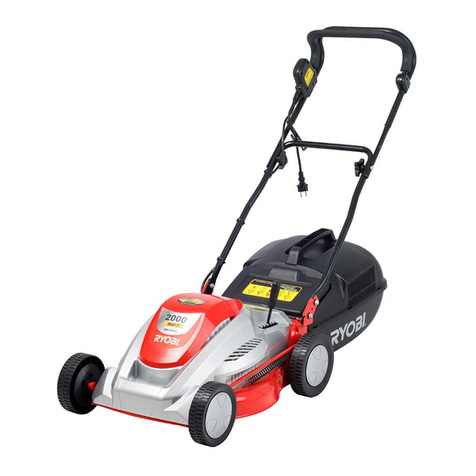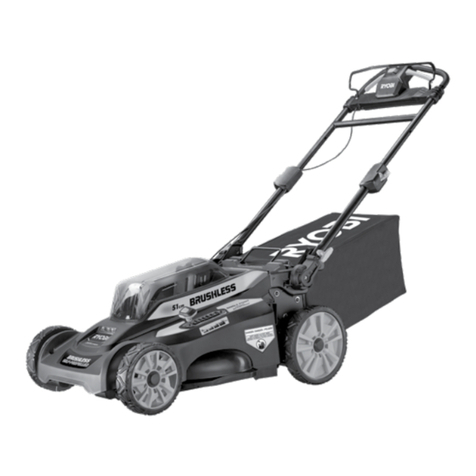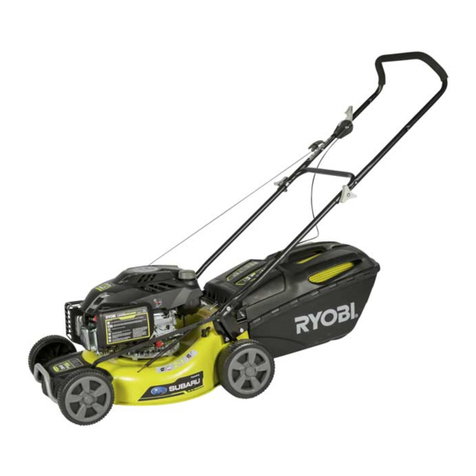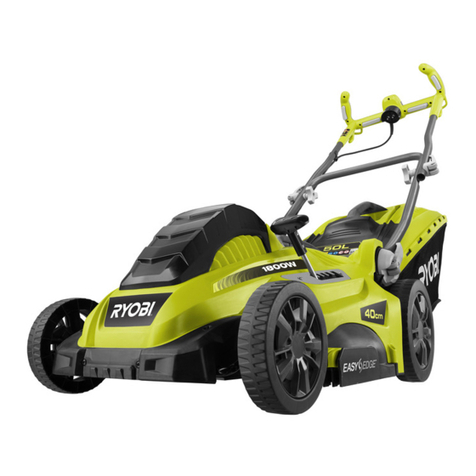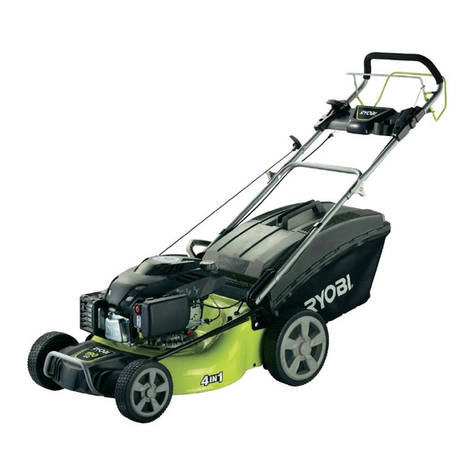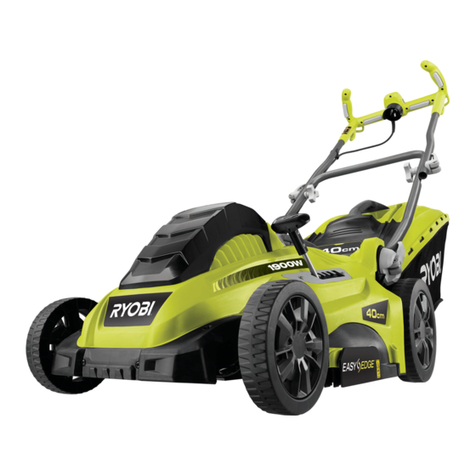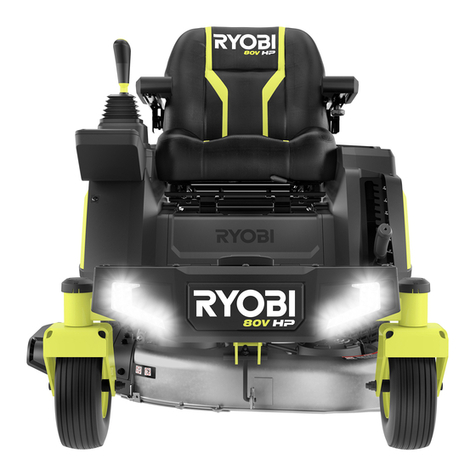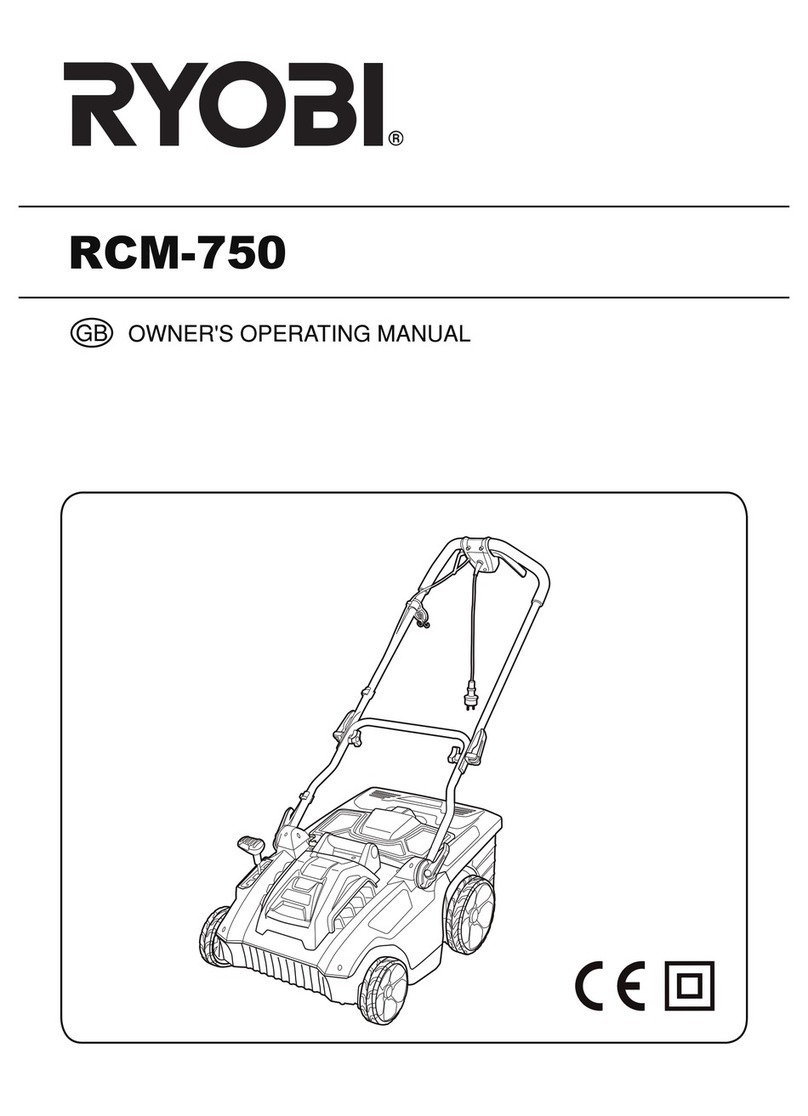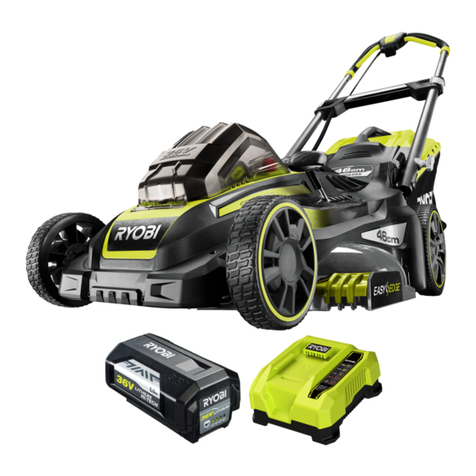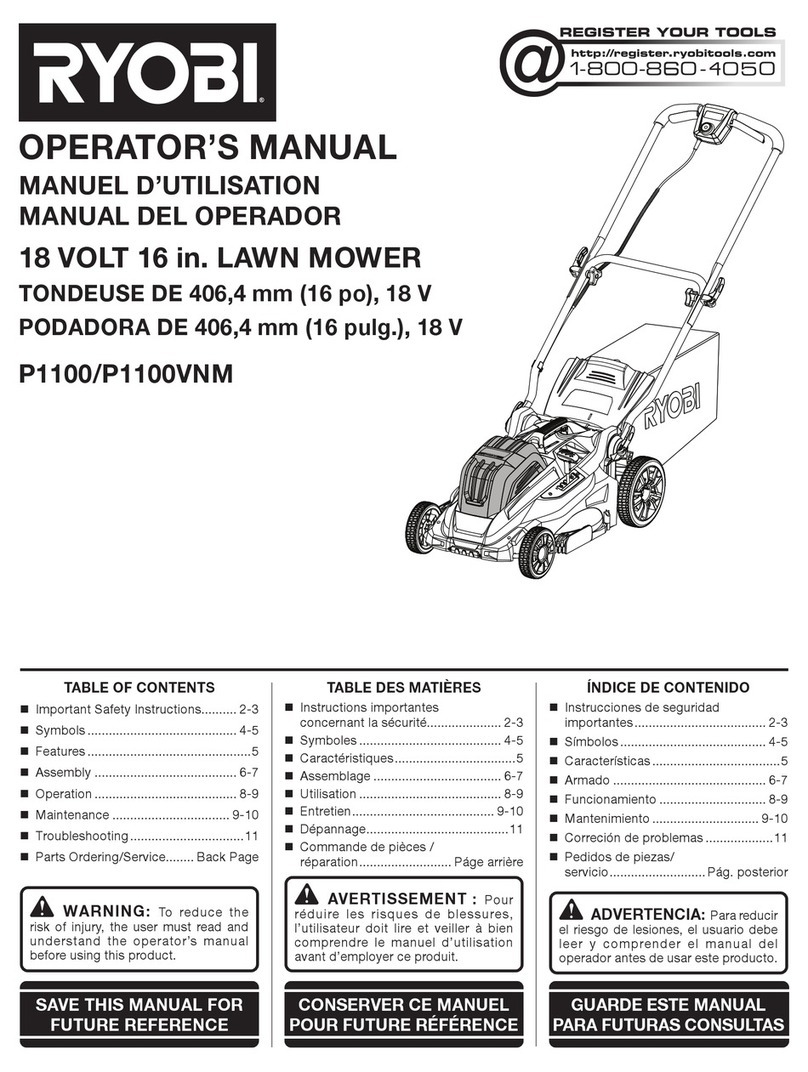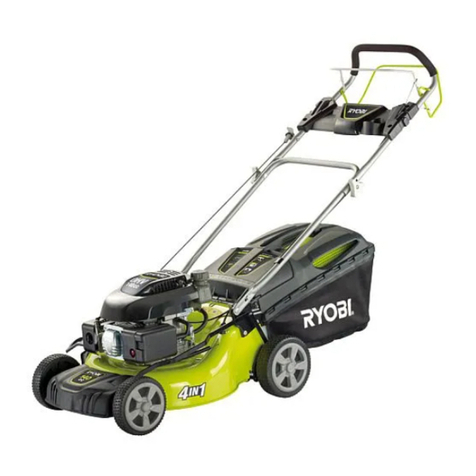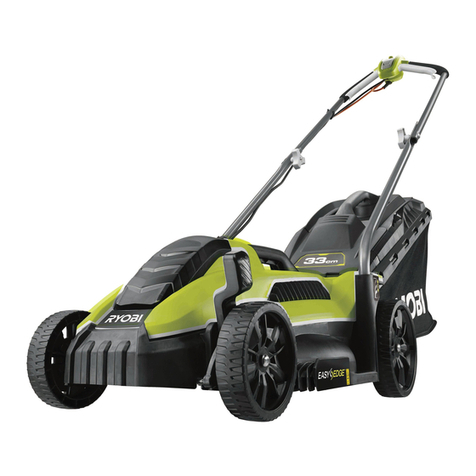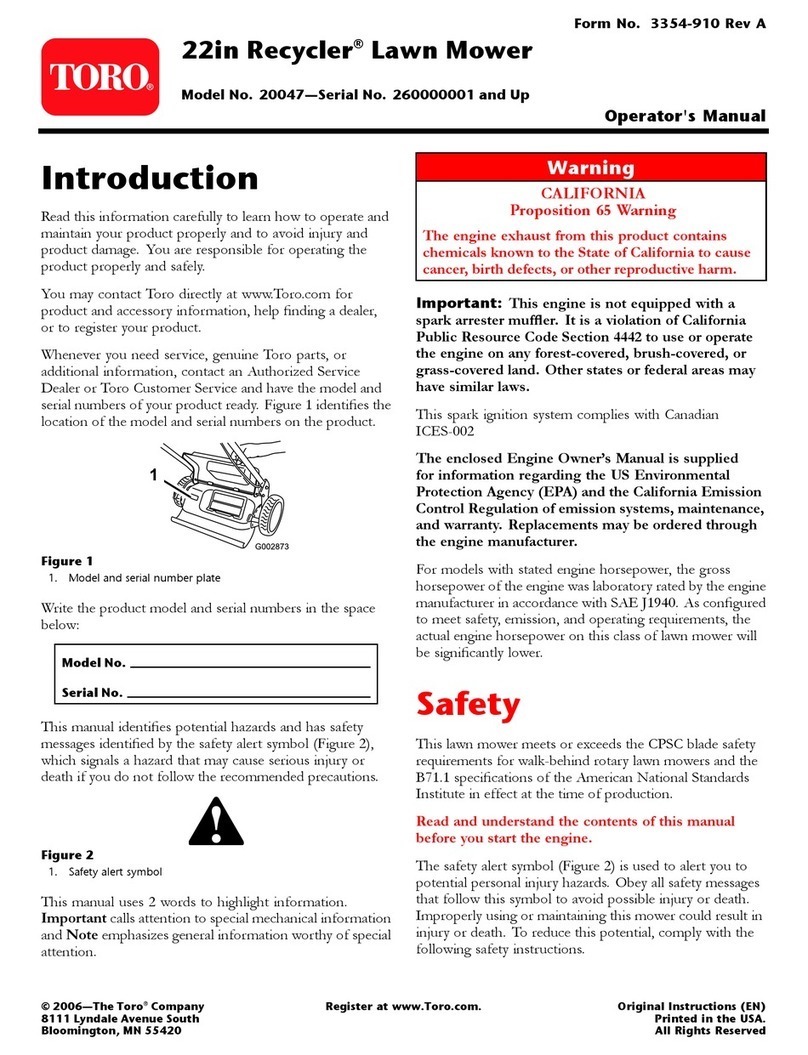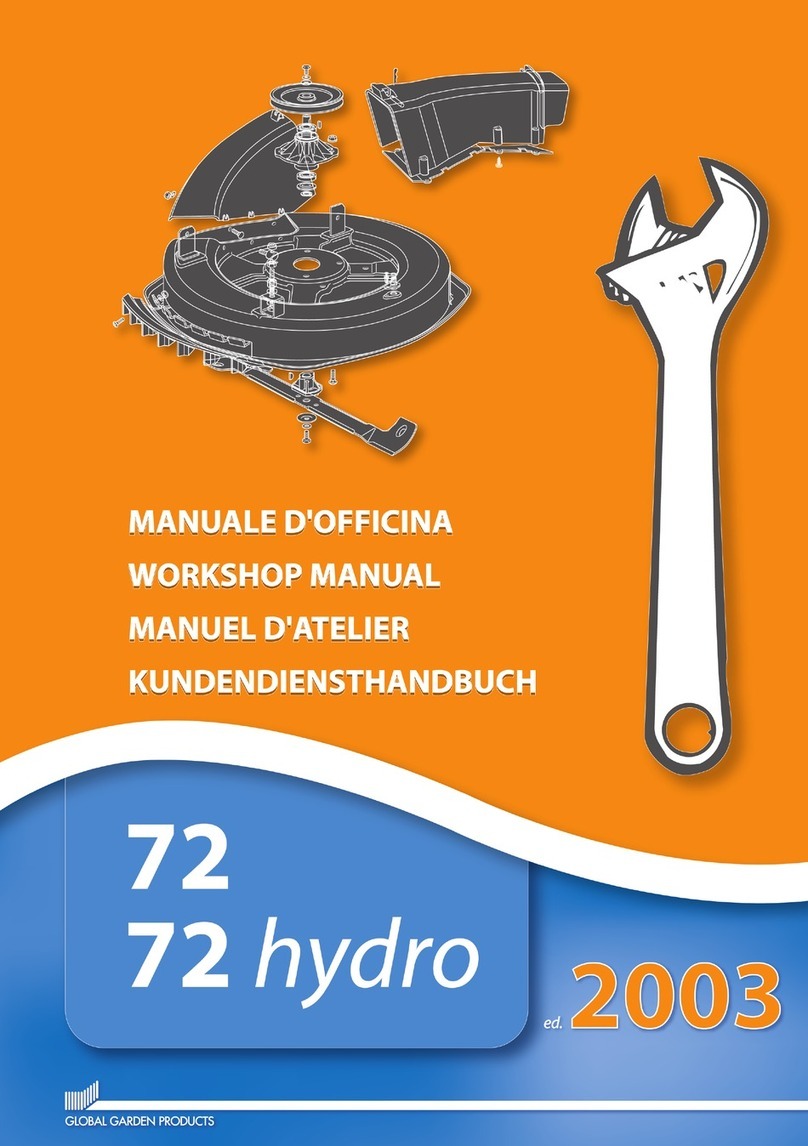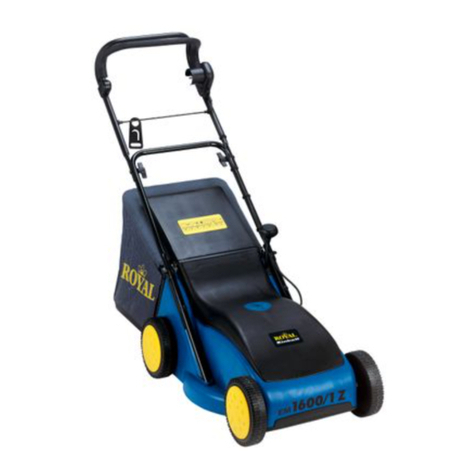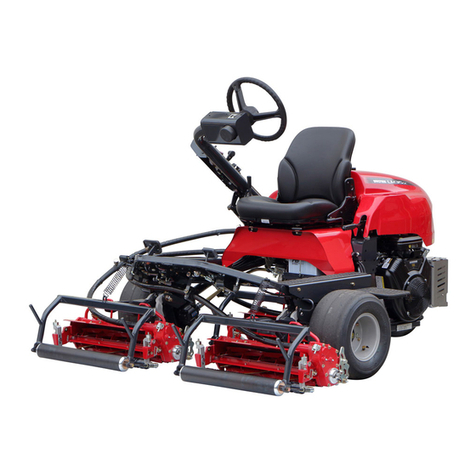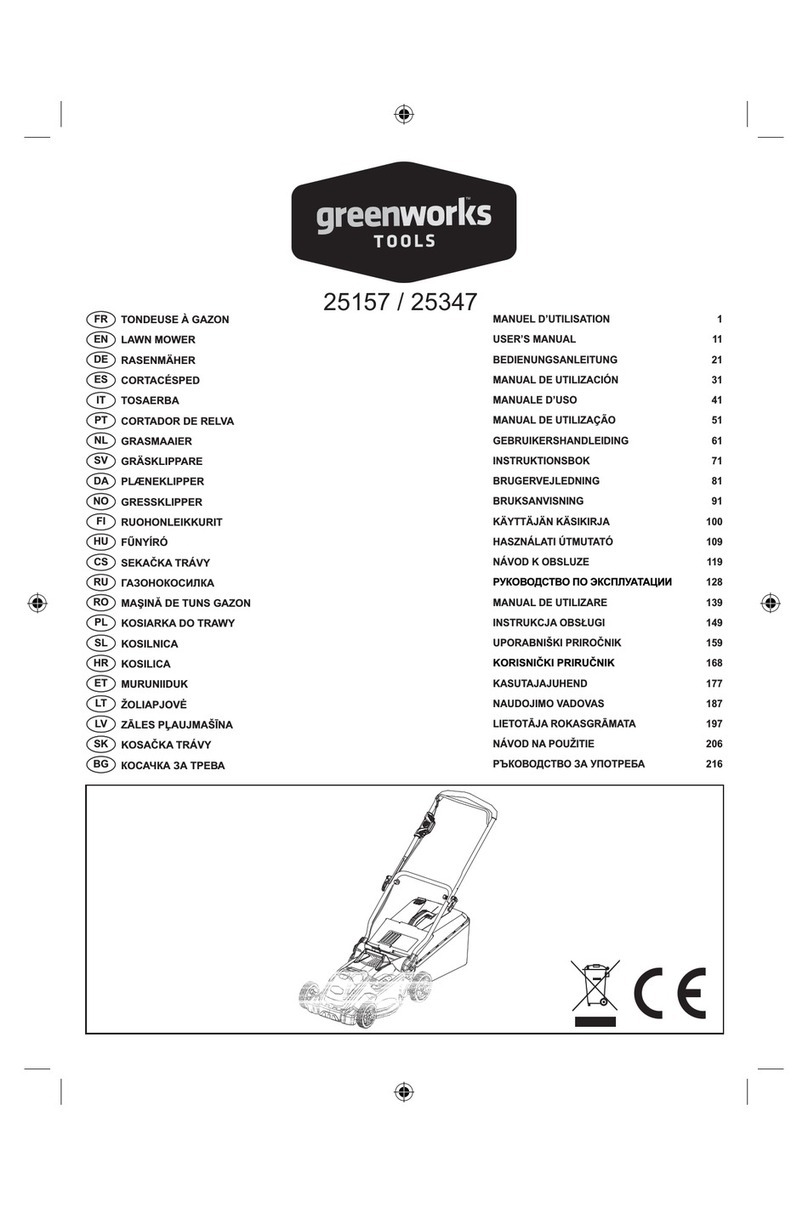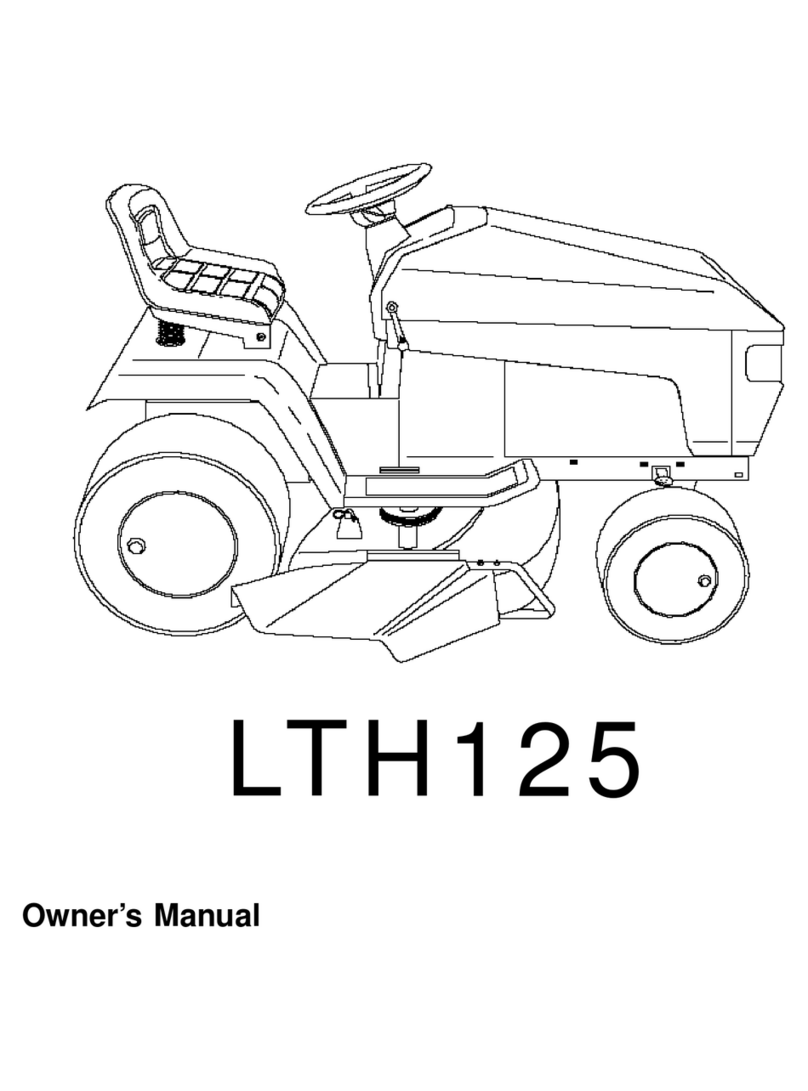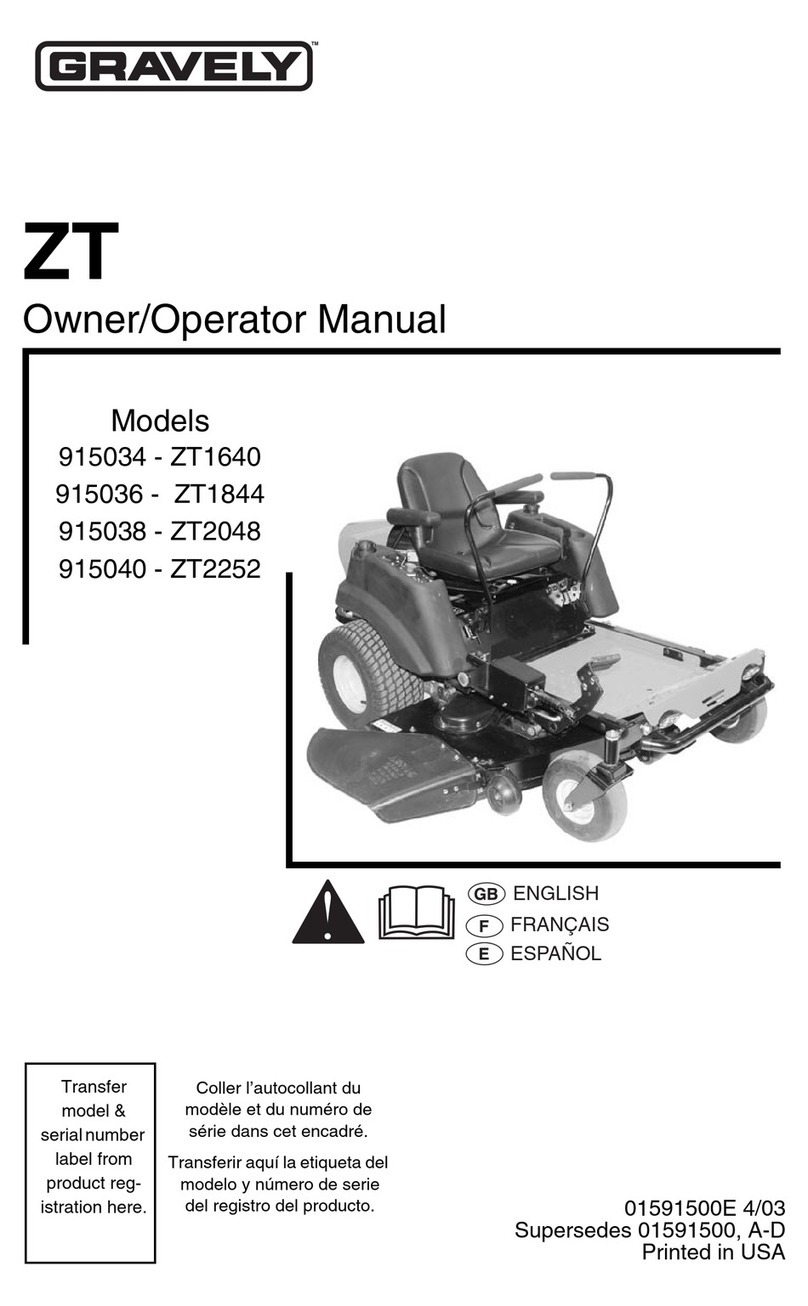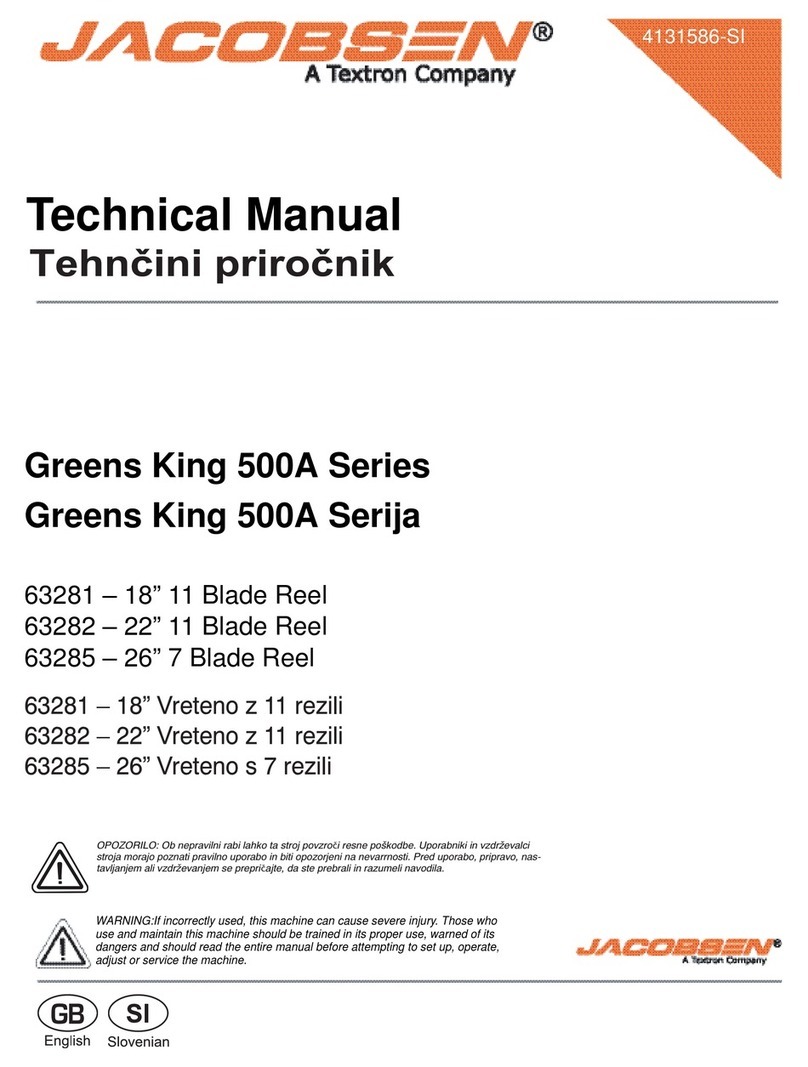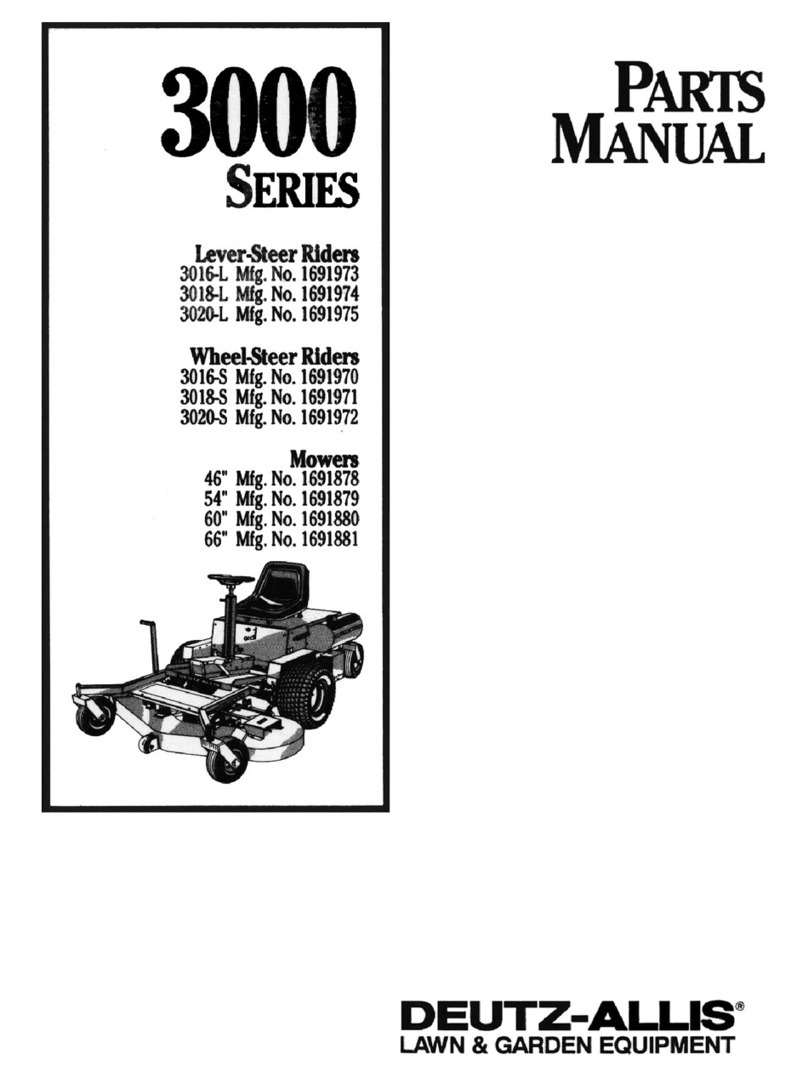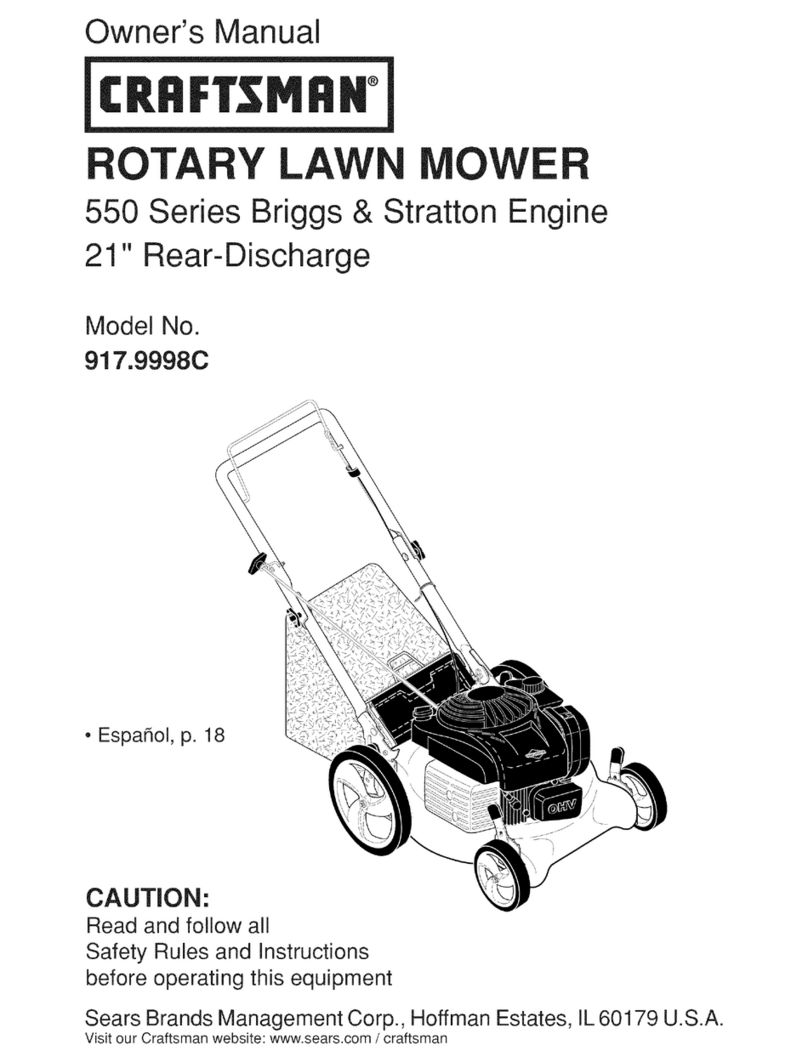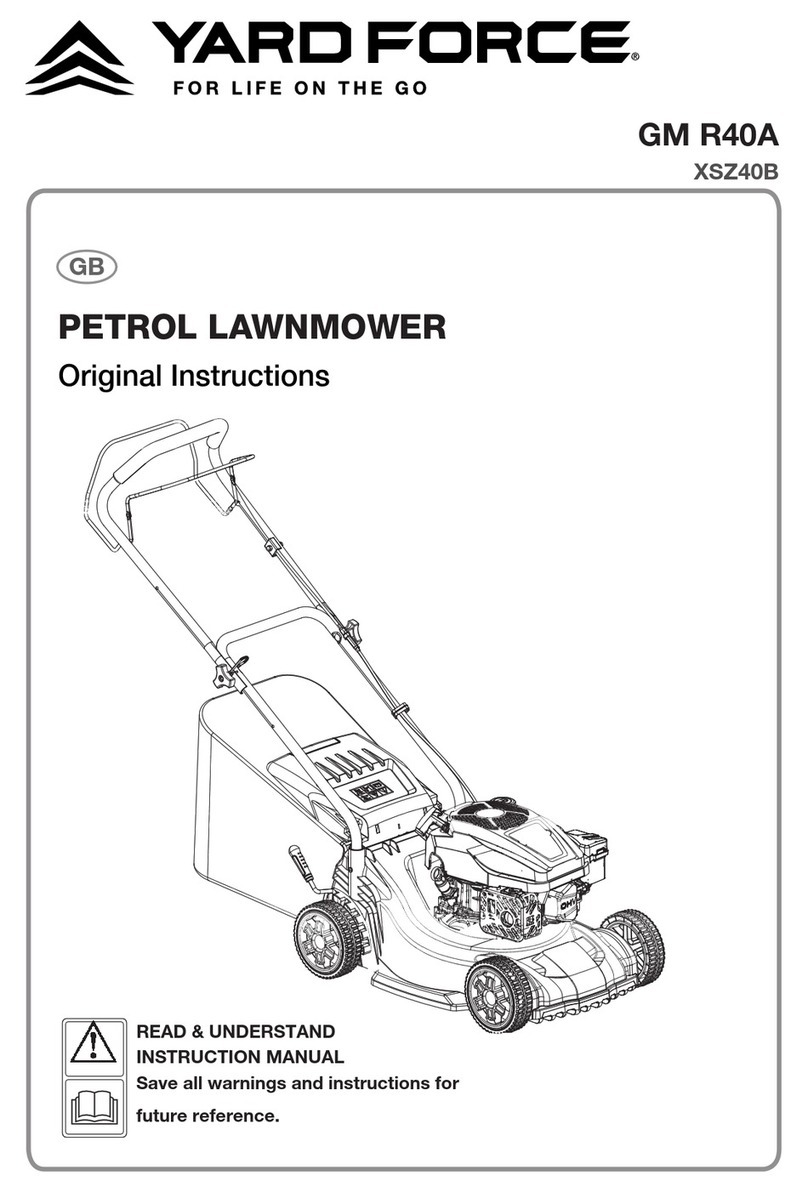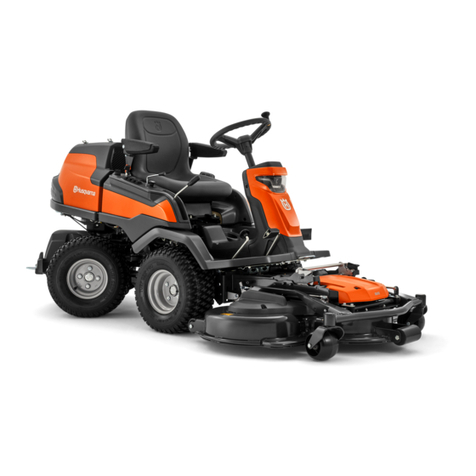
OPERATION
ŶBefore starting the product:
ƔCheck the brake operation.
ƔCheck the tyre air pressure.
ƔCheck for loose fasteners.
ƔMake sure that all guards are in place and working
properly.
ƔCheck the side discharge chute safety interlock
system
ƔTest the operator presence safety interlock system.
ƔAdjust the seat to the preferred position.
ƔVerify the battery charge level.
ŶThe product must be started with the user properly
seated and behind the steering wheel. Never start the
product if:
ƔNot all four wheels are on the ground.
ƔThe side discharge chute is exposed and is not
protected by the mulch cover.
ƔHands and feet of all persons are not clear of the
cutting enclosure.
ŶDisengage the blades when the product is not in use.
ŶDo not operate the product in an enclosed area.
ŶStop the blade when crossing gravel surfaces to avoid
discharging gravel and rocks. Drive the product slowly
and carefully to avoid loss of control.
ŶTurn on the motor carefully according to instructions,
and keep hands and feet away from blades. Do not put
hands or feet near or under rotating parts.
ŶDo not mow in reverse unless absolutely necessary.
Before and while reversing, look behind and down for
small children, bystanders, and pets.
ŶUse extra care when approaching blind corners, shrubs,
trees, or other objects including overhanging shrubs,
which may block your view.
ŶSlow down before turning.
ŶNever leave a running product unattended. Always
engage the parking brake, stop the blades, turn off the
product, and remove the start key before dismounting.
ŶWatch for traffic when operating near roadways. Do not
operate the mower on roadways.
ŶSlopes are a major factor related to loss of control and
tip-over accidents, which can result in severe injury or
death. Operation on all slopes requires extra caution. If
you cannot back up the slope or if you feel uneasy on it,
do not mow it. Never use the product on steep slopes
greater than 15°. Make a copy or cut out the slope guide
at the back of this manual, and use it to determine if the
slope is too steep for safe operation.
ƔMow up and down; not across the face of slopes.
ƔAvoid holes, ruts, bumps, rocks, property stakes, or
other hidden objects. Uneven terrain could overturn
the product. Tall grass can hide obstacles.
ƔUse a slow speed so you will not have to stop
suddenly or accidentally accelerate while on a slope.
ƔDo not mow on wet grass when on a slope. Tyres
can lose traction with the ground and cause you to
lose control of the product.
ƔAlways use the brakes when travelling down the
slope. Do not shift to neutral and coast downhill,
which may cause you to lose control of the product.
ƔAvoid starting, stopping, or turning on a slope. If
the tyres lose traction, disengage the blades and
proceed slowly straight down the slope.
ƔKeep all movement on slopes slow and gradual. Do
not make sudden changes in speed or direction,
which could cause the product to roll over.
ƔUse extra care while using the product with
attachments; they can affect the stability of the
product. Do not use the product on steep slopes
greater than 15°.
ƔDo not try to stabilise the product by putting your foot
on the ground.
ƔDo not use the product near drop-offs, ditches,
excessively steep slopes, or embankments. The
product could suddenly roll over if a wheel goes over
the edge or if the edges caves in and result in death
or serious personal injury.
ADDITIONAL CHARGER SAFETY WARNINGS
ŶThe charger is for indoor use only.
ŶDo not recharge primary cells (non-rechargeable).
ŶBefore every use, examine the supply cord for damage.
If there are signs of damage, it must be replaced by a
qualified person at an authorised service centre to avoid
a hazard.
ŶCharge the product indoors, in a well-ventilated area. Do
not charge the product in a confined space.
ŶThe charger is equipped with a plug featuring a
grounding pin and must be plugged into a matching
outlet that has been properly installed and grounded in
accordance with all local codes and ordinances. Do not
use adaptors or modify the plug provided. If it does not fit
the outlet, have the proper outlet installed by a qualified
electrician.
ADDITIONAL BATTERY SAFETY WARNINGS
WARNING! Risk of ¿re, explosion, or burns. Do not
disassemble, expose to heat above 60 ÛC, or incinerate the
battery pack.
ŶTo reduce the risk of fire, personal injury, and product
damage due to a short circuit, never immerse the tool,
battery pack, or charger in fluid or allow fluid to flow
inside them. Corrosive or conductive fluids, such as
seawater, certain industrial chemicals, and bleach or
bleach-containing products, etc., can cause a short
circuit.
ŶThe battery pack contains acid. If acid comes in contact
with skin or clothing, flush immediately with water for
10 minutes. If liquid comes in contact with eyes, seek
medical help immediately.
ŶDo not charge battery packs that show signs of leaks.
Dispose of them properly.
BATTERY PACK REMOVAL AND PREPARATION FOR
RECYCLING
ŶTo preserve natural resources, recycle or dispose of
batteries properly.
ŶThe product contains lead-acid batteries. Local
regulations may prohibit disposal of lead-acid batteries
in ordinary trash. Consult your local waste authority
for information regarding available recycling and/or
disposal options.
WARNING! Upon removal, cover the battery pack
terminals with heavy-duty adhesive tape. Do not attempt
to destroy or disassemble the battery pack or remove any
of its components. Lead-acid batteries must be recycled or
disposed of properly. Never touch both terminals with metal
ENGLISH
EN
FR
DE
DA
SV
FI
NO
5
Original Instructions
